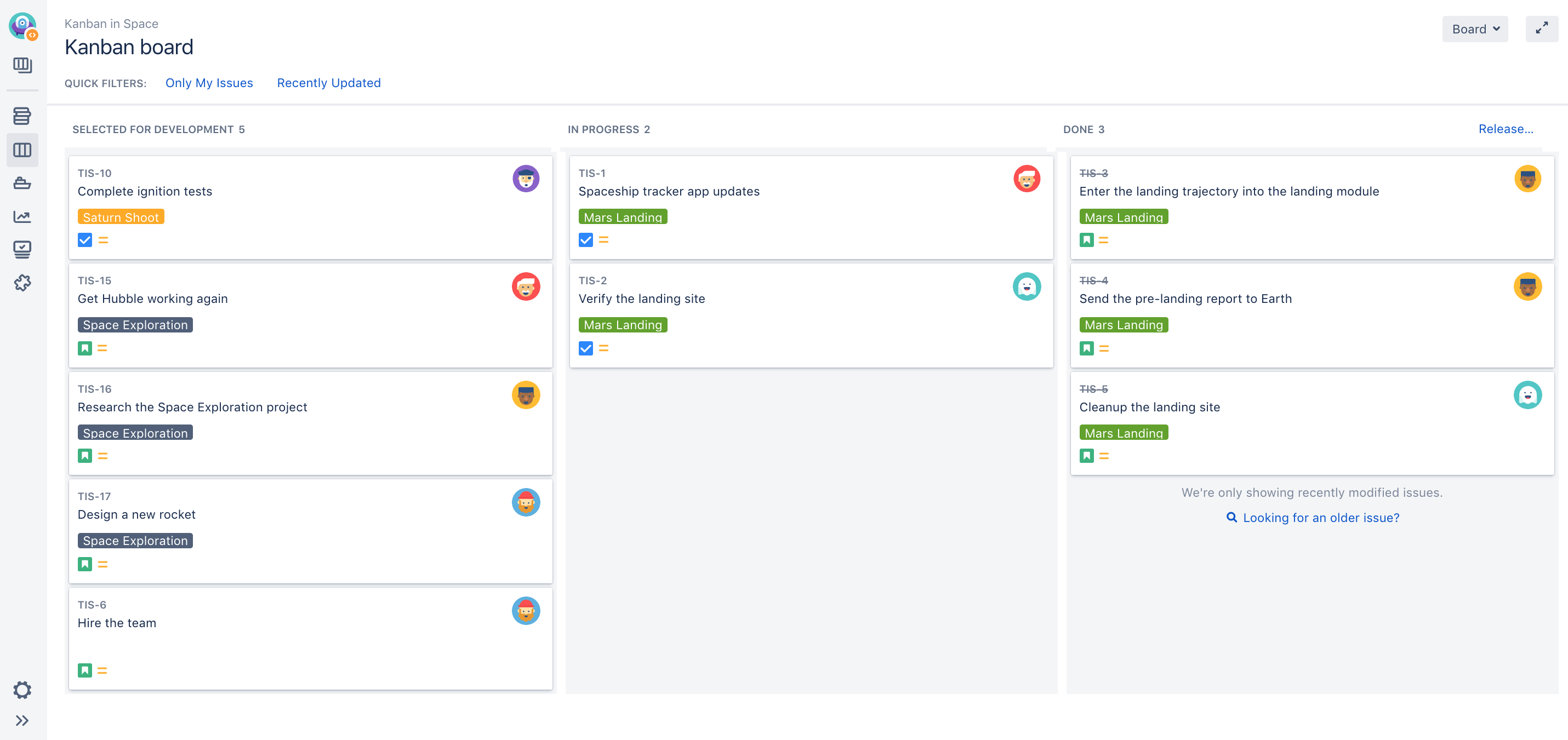Monitoring work in a Kanban project
The Kanban board is a board that was created using the "Kanban" preset (see Creating a board).
Kanban is based on the continuous delivery of work. Rather than plan iterations, the flow of work is constantly monitored to ensure that there are always tasks being worked on. This means that when tasks are completed, new tasks are pulled into work-in-progress.
Use the Kanban board if your team focuses on managing and constraining work-in-progress.
Before you begin
You need to configure the columns for your board. When configuring the columns, make sure to:
- Assign to each state (column) a distinct function in your development process, e.g. in progress, testing, awaiting merge, etc.
- Configure appropriate constraints for the columns.
About the Kanban board
An issue will only be visible in the Kanban board if:
- the issue matches the board's saved filter,
- the issue's status maps to one of the board's columns (but not the 'Done' column), and
- there is at least a status being mapped to the right-most column, e.g. if you have the columns Selected for Development, In Progress, and Done, ensure that you have a status mapped to In Progress at least. If you map all the statuses to the first column ( Selected for Development), you will not be able to see any issues in the Kanban board.
Accessing the Kanban board
Navigate to your desired board and select Kanban board.
What can I do in a Kanban board?
| Task | Instructions |
|---|---|
| Add issues to the Kanban board | Select Create in the header to open the 'Create Issue' dialog and create your issue. The issue will be added to the bottom of the Kanban board. Tip: tick the Create another checkbox in the 'Create Issue' dialog to keep it open, if you are creating multiple issues. |
| Prioritize the Kanban board | Drag and drop an issue to rank it. You can also right-click the issue to open a menu that allows you to send it to the top or the bottom of the column. |
| View an issue's details | Select the desired issue in the board. The issue's details will display in a panel on the right of the board. For information on how to configure the issue detail panel, see Configuring the issue view. If you want to select an issue rather than open the issue's details, use ctrl-left-click or command-left-click. |
| Estimate stories | Use the 'J' and 'K' keys to move through issues in the board and show the details on the right-hand side of the screen. Use the 'E' key to edit an issue, then update estimates or story points as you go. By default, the Story Points field is only available to issues of type 'Story' or 'Epic', see Configuring estimation and tracking for details. |
| Identify the workload for specialists | The avatars for users (specialists) who have work assigned to them in a sprint are shown at the top of a sprint. Select ... (next to avatars) to view the sprint workload for assignees. |
| Create sub-tasks | Select the desired issue, press the '.' key, and type 'create sub-task' to open the 'Create Sub-task' dialog. Create the sub-task as desired. Sub-tasks are useful for breaking a story (issue) down into implementable chunks. |
| Flag an issue | Right-click an issue to open a menu, and select Add flag. |
| Filter issues | Select the desired Quick Filter (below the board name), e.g. Only my issues. See Configuring Quick Filters for details. |
| Release issues | Select Release to release completed issues. When you release issues, these issues no longer appear in the Done column, and a release version is created, which you can view in the Releases tab of the project. |
| Hide issue detail view | If you're switching between the issues quite often, it might be useful to hide the issue detail view that appears on the right of the backlog. You can do it by selecting More > Hide detail view. |
Next steps
Need help? If you can't find the answer you're looking for in our documentation, we have other resources available to help you. Check out Getting help.
Read the following related topics:
